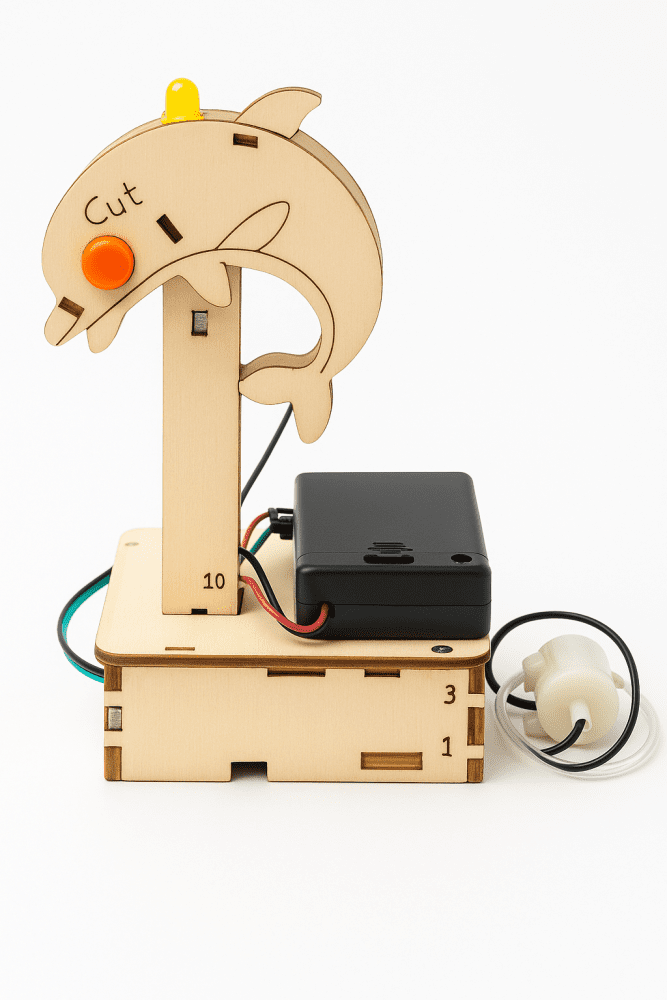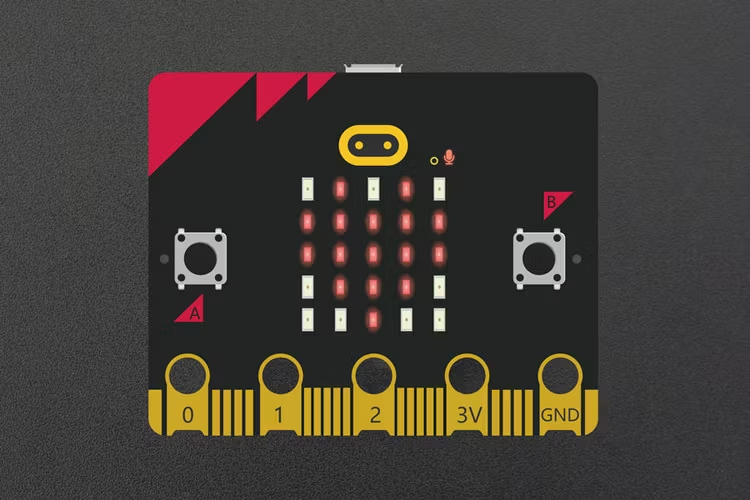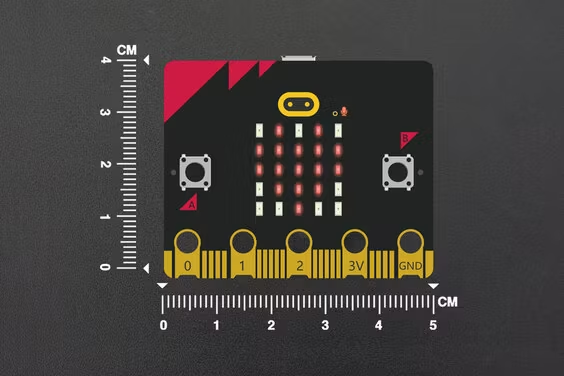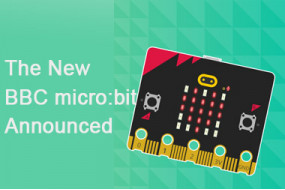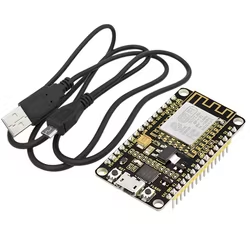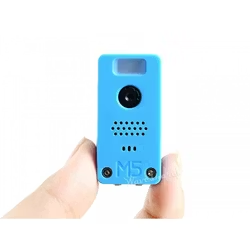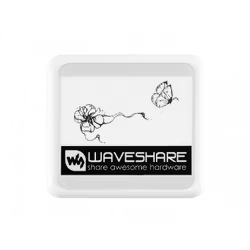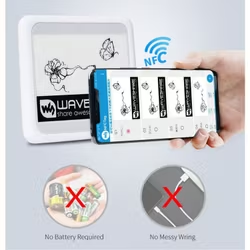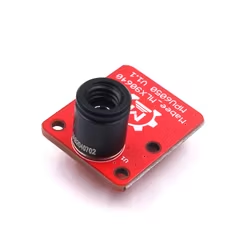micro:bit v2 - with speaker, microphone, accelerometer, 2.4GHz radio/ BLE 5.0
New micro:bit v2 has a lot of features and is completely programmable. Each of its LEDs can be individually programmed. It is also equipped with a MEMS microphone, speaker, and touch-sensitive logo. If you want to realize wireless projects, it is equipped with a 2.4GHz micro:bit radio and BLE Bluetooth 5.0. Also, It has 25 red LEDs that can flash messages and two programmable buttons that can be used to control games or pause and skip songs on a playlist. micro:bit v2 can also detect motion and tell you in which direction you’re heading in with the help of the onboard accelerometer.
PRODUCT DETAILS
Features
- Pocket-sized microcontroller (4 x 5cm) designed for kids and beginners
- Wireless connectivity with built-in 2.4GHz micro:bit radio and BLE Bluetooth 5.0
- 25 red LEDs that can be used for interactions
- Onboard MEMS microphone, speaker, and touch-sensitive logo
- Onboard accelerometer for motion sensing applications
- Notched edge connector for easier connections
- Dedicated I2C bus for peripherals
- Two programmable buttons
Description
micro:bit v2 is a pocket-sized microcontroller designed for kids and beginners learning how to program, letting them easily bring ideas into DIY digital games, interactive projects, and robotics. You can use your BBC micro:bit for all sorts of cool creations, from robots to musical instruments. The possibilities are endless.
You can code, customize, and control micro:bit to bring your digital ideas, games, and apps to life. Measuring 4cm by 5cm, and designed to be fun and easy to use, users can create anything using micro:bit, from games and animations to scrolling stories at school, at home, and on the go. All you need is imagination and creativity.
micro:bit v2 has a lot of features and is completely programmable. Each of its LEDs can be individually programmed. It is also equipped with a MEMS microphone, speaker, and touch-sensitive logo. If you want to realize wireless projects, it is equipped with a 2.4GHz micro:bit radio and BLE Bluetooth 5.0. Also, It has 25 red LEDs that can flash messages and two programmable buttons that can be used to control games or pause and skip songs on a playlist. micro:bit v2 can also detect motion and tell you in which direction you’re heading in with the help of the onboard accelerometer.
Specifications
| Specification | Details |
|---|---|
| Processor | Nordic Semiconductor nRF52833 |
| Memory | 512KB Flash, 128KB RAM |
| Interface | NXP KL27Z, 32KB RAM |
| Microphone | MEMS microphone and LED indicator |
| Speaker | On-board speaker |
| Logo touch | Touch-sensitive logo |
| Edge Connector | 25 pins. 4 dedicated GPIO, PWM, I2C, SPI and ext.power. 3 ring pins for connecting crocodile clips/banana plugs. Notched for easier connection |
| I2C | Dedicated I2C bus for peripherals |
| Wireless | 2.4GHz micro:bit Radio/BLE Bluetooth 5.0 |
| Power | 5V via micro-USB port, 3V via edge connector or battery pack, LED power indicator, Power off (push and hold the power button |
| Current available | 200mA available for accessories |
| Motion Sensor | ST LSM 303 |
| Software | C++, MakeCode, Python, Scratch |
| Size | 5cm(w) x 4cm(h) |
Comparison between the current version (v1.5) and the latest version (v2.0)
| Current Version (v1.5) | Latest Version(v2) | |
|---|---|---|
| Processor | Nordic Semiconductor nRF51822 | Nordic Semiconductor nRF52833 |
| Memory | 256KB Flash, 16KB RAM | 512KB Flash, 128KB RAM |
| Interface | NXP KL26Z, 16KB RAM | NXP KL27Z, 32KB RAM |
| Microphone | N/A | MEMS microphone and LED indicator |
| Speaker | N/A | On-board speaker |
| Logo touch | N/A | Touch-sensitive logo |
| Edge Connector | 25 pins. 3 dedicated GPIO, PWM, I2C, SPI and ext.power. 3 ring pins for connecting crocodile clips/banana plugs | 25 pins. 4 dedicated GPIO, PWM, I2C, SPI and ext.power. 3 ring pins for connecting crocodile clips/banana plugs. Notched for easier connection |
| I2C | Shared I2C bus | Dedicated I2C bus for peripherals |
| Wireless | 2.4GHz micro:bit Radio/BLE Bluetooth 4.0 | 2.4GHz micro:bit Radio/BLE Bluetooth 5.0 |
| Power | 5V via micro-USB port, 3V via edge connector or battery pack | 5V via micro-USB port, 3V via edge connector or battery pack, LED power indicator, Power off (push and hold power button |
| Current available | 90mA available for accessories | 200mA available for accessories |
| Motion Sensor | ST LSM 303 | ST LSM 303 |
| Software | C++, MakeCode, Python, Scratch | C++, MakeCode, Python, Scratch |
| Size | 5cm(w) x 4cm(h) | 5cm(w) x 4cm(h) |

Board Changes
Speaker: Addition of a speaker at the back of the board, but you need to carefully check when accessories are mounted closer to the board than the depth of the current JST connector. By default, the micro:bit will output sound to both the edge connector pins and the onboard speaker. If your accessory makes use of a speaker, you may wish to disable the onboard speaker. This will need to be done in software.
Microphone: Addition of a rear-mounted MEMS microphone with a sound input hole on the front of the board, with a microphone activity LED. Make sure not to cover the microphone and the microphone LED when mounting on accessories.
Touch-sensitive logo: Addition of capacitive touch support to the micro:bit logo which is made of gold plated copper. Capacitive touch is used for the large pins on the micro:bit v2 as opposed to the resistive touch present in the micro:bit v1.5.
Antenna: Change of position of the antenna with an angle and coating it with copper to make it more visible. If your accessory makes use of radio or Bluetooth, it’s better to test your software packages with both board revisions.
Hardware Changes
I2C Bus: Addition of dedicated external I2C lines from the nRF52 of micro:bit v2 to use with accessories as opposed to the shared I2C bus on the micro:bit v1.5
Power: micro:bit v2 can be powered from the two lozenge-shaped pads on the rear of the board and the 3V/GND pins. The nRF52 supplies 300mA to drive the board. 100mA is reserved for powering onboard components. 200mA is then available for accessories.
Software Changes
MakeCode extensions: If your MakeCode extension makes use of mBed or the DAL, you may need to revise them to be compatible with CODAL and both revisions of the board. The latest revision no longer makes use of mBED.
Python modules: Additional memory helps to have more space to create Python modules to work with your accessories and the micro:bit.
Exciting things that you can do with a micro:bit v2
Part List
- 1 x micro:bit v2
- 1 x User guide
ECCN/HTS
| HSCODE | 8543709990 |
| UPC |

 Svenska
Svenska
